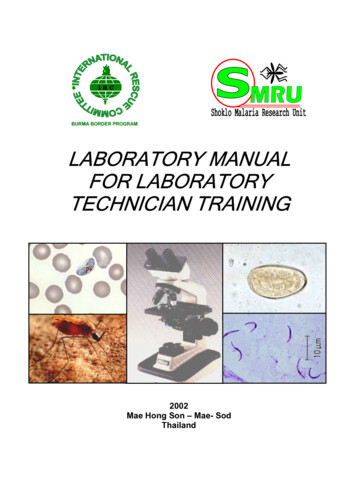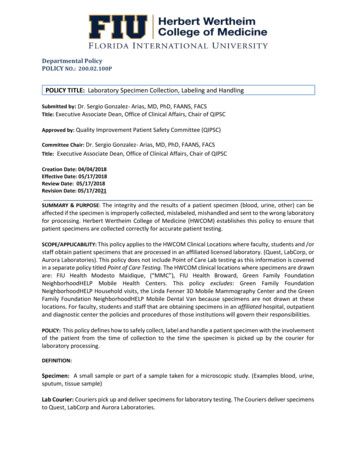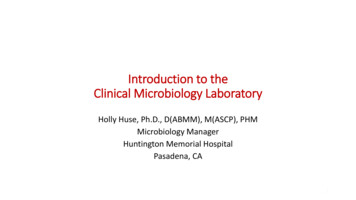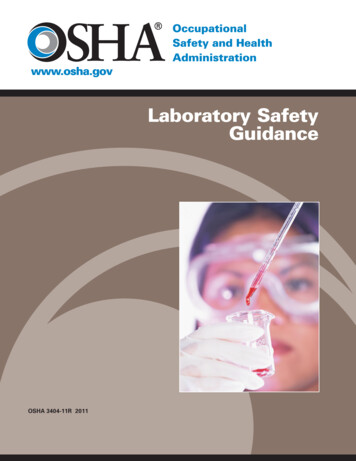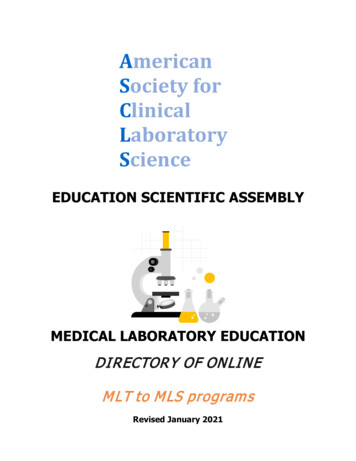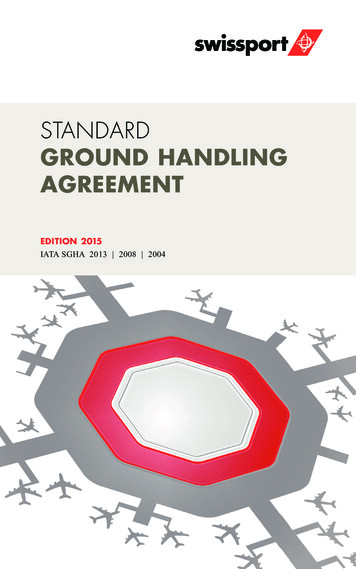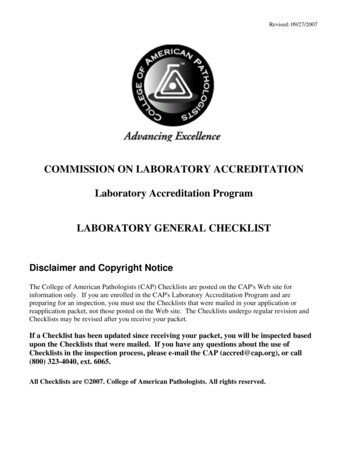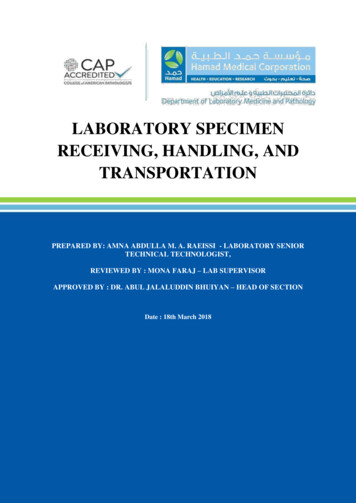
Transcription
LABORATORY SPECIMENRECEIVING, HANDLING, ANDTRANSPORTATIONPREPARED BY: AMNA ABDULLA M. A. RAEISSI - LABORATORY SENIORTECHNICAL TECHNOLOGIST,REVIEWED BY : MONA FARAJ – LAB SUPERVISORAPPROVED BY : DR. ABUL JALALUDDIN BHUIYAN – HEAD OF SECTIONDate : 18th March 2018
I: SPECIMEN HANDLING AND RECEIVING :1. PURPOSE:1.1 The objective of this Standard Operating Procedure (SOP) is to describe the necessarystepwise procedures relevant to transporting, receiving and handling of specimens submitted tothe Specimen Receiving Section in the Department of Laboratory Medicine and Pathology(DLMP) from all HMC Inpatient, Outpatient facilities, Women’s Hospital, and other outsidesources, like Primary Health Care Centers (PHCC), Non-HMC Clients.1.2 This SOP aims to maintain patient confidentiality, prevent sample mix up and ensureSpecimen integrity and overall quality handling of specimen; consequently, ensuring quality Labtest results are being produced by HMC DLMP.1.3 This SOP will be in compliance with the International College of American Pathologists(CAP) standards and HMC Management of Laboratory Specimens Policy CL 7067.2. DOCUMENTATION:2.1 Rejection Sheet.2.2 Sample Transportation Policy2.3 Log Books:2.3.1 Molecular Biology2.3.2 Cytogenetic2.3.3 Molecular Genetics2.3.4 Private Clinics2.3.5 NCCCR Flow cytometry2.3.6 VVIP Blood Samples2.3.7 Labeling Irretrievable Specimen as required2.3.8 HGED log book2.3.9 Thyroglobulin, H.Pylori Stool (Al Wakra)2.3.10 Mobile Doctor’s samples (Chemistry & Hematology)2.4 Cerner Samples-Transfer List:2.4.1 Cerner Tracking2.4.2 Virology & Molecular Biology2.4.3 Immunology & Histocompatibility2.4.4 Cytogenetics2.4.5 Molecular Genetics2.4.6 TB samples2.4.7 Metabolic (Amino acid)2.4.8 Chemistry & Hematology (Stat samples)2.4.9 Special Chemistry2.4.10 Microbiology (Corneal specimens & Eye swab for one month old babies, All Bodyfluids)3. SPECIMEN REQUIREMENTS: ( Collection, Handling, Transportation & Storage);3.1 The phlebotomists or nurses should receive a request form or Cerner electronic request filledwith required patient identification data: full name, date of birth, health card number, andnationality and Qatar ID number .They should identify the patient against the mentionedinformation in the Request form before collecting specimens, as per Patient IdentificationPolicy CL 7026.Page 2 of 15LABORATORY SPECIMEN RECEIVING, HANDLING, AND TRANSPORTATION
3.2 Laboratory samples or specimens should be properly collected by the nurse or phlebotomist,identified and transported from patient care areas and received by the Central Processing andSpecimen Receiving Laboratory.3.3 Handling and transportation of specimens should be in accordance with the Infection Controlstandards of Practice, with special reference of categories of Isolation precautions asspecified in Policy CL 7233.3.4 The Central Specimen receiving and Processing staff receive specimens along with paperbased request from (non-Cerner site)and register/log-in in Cerner PathNet (LIS) and printbarcode with requested test name. Specimens then checked for integrity and correctness fortest ordered; sorted and distributed by lab aides/trained drivers of DLMP specimen transportvehicles to analytical laboratories with transfer list (for labs that are outside of HGH) orelectronic log-in (HGH labs) for sample tracking. Specimens that are arriving with CernerPathNet barcoded stickers with test names and required information logged-in here only;then sorted and distribute to respective analytical labs by lab aides/drivers as mentioned.4. EVENTUAL PROBLEMS OR PITFALLS:4.1 Non-Cerner & Cerner Specimens delivered to the Central processing and specimen receivinglaboratory are rejected for the following reasons:4.1.1 The specimen received without patient identification label or unlabeled.4.1.2 The specimen label does not match the label on the attached request form ormislabeled.4.1.3 Request form or Label with insufficient information.4.1.4 Request form has no physician stamp and/or signature.4.1.5 Request form received with no mark on the required test.4.1.6 Specimen is collected in improper container or tube.4.1.7 General or unspecific tests names mentioned in the request form.4.1.8 Leaking or contaminated container.4.1.9 Wrong request form or wrong requested test that is not related to the request formtype.4.1.10 Request form received without specimens and vice versa.4.1.11 Test requested is not available.4.1.12 In complete stickers for Cerner specimen.4.1.13 Receiving more than single specimen in one biohazards bag.4.1.14 Wrong Encounter, Canceled order specimens, Wrong order by doctors & Stickers ofcompleted orders.4.1.15 Receiving dispatched samples should be corrected at the same time.4.1.16 Receiving one sample with more than one accession number.4.1.17 Re-labelling of mislabeled specimen should not be entertained or allowed on aroutine basis. Exceptions are when the specimen is extremely difficult to collect, forexample CSF, tissue, blood from infants and premature babies. If relabeling allowed,the collector is required to attend Central Processing and relabel samples as required.At this juncture the cause of sending mislabeled sample is identified with the date,time signature and corporation by completing form PCR PM 001 006 000Labeling of Irretrievable Specimens.4.1.18 For inpatients the laboratory staff shall inform the Head Nurse/ChargeNurse/Staff Nurse of the unit of the reason for rejection as soon as possible,who shall in turn inform the requesting physician and a new specimen shall beordered and collected if needed.4.1.19 For outpatients respective phlebotomy / technologist area shall be informedwho in turn will inform the ordering physician about the rejection and makethe arrangement for re-collection, if necessary (inpatients and outpatientscommunications should be documented in the log-book or online systemPage 3 of 15LABORATORY SPECIMEN RECEIVING, HANDLING, AND TRANSPORTATION
LIS).4.1.20 A rejected specimen should be documented in the rejection log sheet orelectronically with the reason for the rejection. All available information related tothe specimen, date and time of rejection, signature of the laboratory staff and theaction taken should be mentioned.4.1.21 All rejected samples are reported electronically by filling up an “OccurrenceVariance Report” OVA with 24 hours.5. STEP BY STEP PROCEDURE;5.1 Non Electronic System:5.1.1All specimens should be properly collected, identified from patient care areas andreceived by Specimen Receiving section.5.1.2 Specimens are usually transported to the Specimen Receiving in a rack or inindividual biohazard plastic bag in a specimen transportation box accompanied by arequest form.5.1.3 When Specimens have arrived at the Specimen Receiving area the following stepsmust be taken:5.1.3.1 The specimen receiving staff receives the specimen and checks for anyleakage.5.1.3.2 The specimen receiving staff removes the sample from rack or plastic bag.5.1.4 Check specimen label against the request form. The request form should be fullycompleted with the following information:5.1.4.1 Patient’s full name and HC number.5.1.4.2 Patient’s date of birth and sex.5.1.4.3 Date and time of collection.5.1.4.4 Type of samples or specimen.5.1.4.5 Location and telephone number.5.1.4.6 Adequate clinical data.5.1.4.7 Test required.5.1.4.8 Physician stamp.5.1.4.9 Identification of specimen for STAT tests.5.1.4.10Collector name, signature & Corp.#5.1.5 All routine Specimens should be accepted daily during regular hours. Specimens alsoare accepted out of regular hours for storage and sending later to designatedlaboratory sections.5.1.6 Chemistry Endocrinology, routine samples are registered at HGCP from 7:00AM4:00PM.Any samples received after 4:00PM, the registration will be at ChemistryLab.5.1.7 Stat chemistry samples are registered at Chemistry Lab5.1.8 Time stamp the request forms.5.1.9 Virology samples are registered from 7:00AM-4:00PM, at HGCP. Any samplesreceived after 4:00PM ,the samples are kept at HGCP refrigerator for the next daymorning registration5.1.10 Molecular Biology samples are sent to Virology lab for registration5.1.11 Microbiology Samples are registered from 7:30AM-3:30PM at HGCP. Any urgentsamples received after 3:30PM, the registration will be at Microbiology lab. As forroutine samples received after 3:30PM, the registration must be done the next day atHGCP.Page 4 of 15LABORATORY SPECIMEN RECEIVING, HANDLING, AND TRANSPORTATION
5.1.12 Immunology and Histocompatibility samples are registered at HGCP from 8:00AM4:00PM. Any samples received after 4:00PM,the registration must be done next daymorning at HGCP.5.1.13 STAT tests should be accepted 24/7 and processed accordingly.5.1.14 Arrange all specimens in the racks.5.1.15 Send all samples and specimens by lab aides or drivers to all the designatedlaboratory sections.5.1.16 STAT Samples from Outpatients:5.1.16.1Phlebotomy staff should bleep specimen receiving lab for STAT samples.5.1.16.2 Lab aide should collect the specimen from OPD and deliver it to HGCPwithin 15 minutes, using Transport boxes.5.1.16.3Technician or Assistant technician should check and register the STATsample in the “OPD STAT” Book.5.1.16.4 Then submit it to the concerned section immediately.5.2 Electronic System (Cerner):5.2.15.2.25.2.35.2.45.2.55.2.6Check the Cerner sticker if the test and sample are matching with the container/TubeMake sure that the Encounter(Should be in HG)Make sure the sample if stat or routineMake sure status of each specimen is "Collected"Log in all specimens.Specimens have to be rejected if the status is shown as "Dispatch “and follow thecriteria of rejection (4.1).5.2.7 Identify "STAT" specimens and send within 10 min. to the individual labs concernedby lab aids.5.2.8 Sort all specimens according to the section where they should be delivered5.2.9 Create Transfer List for Metabolic lab, Cytogenetic, Virology & Molecular Biology,Molecular Genetics, Immunology & Histocompatibility, TB Lab, STAT ChemistryLab (All samples received with ice, ketones, all Microtainer samples includingroutine orders), Microbiology (All body fluids, Corneal specimens, Eye swab forbabies that are one month old, Special Chemistry, STAT Hematology and Qatar Biobank (Pre-marital samples).5.2.10 Send routine specimens by lab aids to the concerned labs.5.2.11 Collect Transfer List from Cytogenetics, Molecular Biology, Immunology,Histocompatibility, TB , STAT Chemistry, Microbiology and Special ChemistryLabs after ensuring that the same has been acknowledged with signature, date andCorporation Number by the Technician.5.3 Sections (Exceptions):5.3.1Chemistry and Special Chemistry:5.3.1.1 All urine specimens received after 12pm should be stored in the Chemistryrefrigerator from Friday to Wednesday. And on Thursday, the samplesreceived after 1:00PM should be stored at Chemistry refrigerator till the nextday.5.3.1.2 Note: STAT urine specimen should be sent immediately to Chemistry Labwith transfer list, after 02:00PM.5.3.1.3 Blood Gas Specimens Venous Blood Gas received from OPD should bedelivered directly to HGED lab by HGCP Lab Aide.5.3.1.4 Rapid PTH from operating theatre should be requested by physician and/ornurse and delivered directly to Chemistry lab. If sample delivered to centralprocessing incorrectly sample should be rerouted directly to chemistry.Page 5 of 15LABORATORY SPECIMEN RECEIVING, HANDLING, AND TRANSPORTATION
5.3.25.3.1.5 Cryoglobuline test send directly to Special Chemistry lab directly.5.3.1.6 All special Chemistry samples received from 2:00PM – 06:00AM should besent to Chemistry Lab.5.3.1.7 Outpatient with request for Cryoglobulins test:5.3.1.7.1 Patients go to OPD Phlebotomy area to receive appointment.5.3.1.7.2 Phlebotomy staff must call special chemistry lab to arrange appointmentfor patients.5.3.1.7.2.1 Phlebotomy staff should inform the patient to come to the Lab halfan hour before their appointment.5.3.1.7.2.2 Once patient arrives for blood collection, phlebotomist must call theSpecial Chemistry lab to arrange for flask. Once the flask is ready,the phlebotomist will call HGCP at Tel. numbers: 2040/3180/ tosend lab aid to Special Chemistry in order to take the flask.Microbiology:5.3.2.1 Create transfer list for Non Cerner & Cerner samples, All body fluids,Corneal specimens and Eye swabs of babies that are one month old and sentto Microbiology Lab at the same time. The Technical Staff in theMicrobiology Lab must sign the book or transfer list upon received and sendit back to HGCP for filling.5.3.2.2 All Health Centers and other Non-HMC Clients (Army, Police etc.)microbiology specimens must be sent to Al-Khor Hospital, except fungaland TB samples.5.3.3Blood Bank:5.3.3.1 All inpatient, Private Hospitals have to be directly delivered to the BloodBank section.5.3.3.2 OPD, PHCC and Non-HMC Clients’ specimens must be received at HGCPand sent to Blood Bank after time-stamping the request forms.5.3.4Histopathology:5.3.4.1 All specimens should be delivered directly to Histopathology lab up to3:00PM.After 3:00PM and during weekends, the specimens have to bestored at room temperature in HGCP.5.3.4.2 Frozen sections should be delivered directly to Histopathology Laboratory.5.3.4.3 For all Histopathology specimens without Formalin (Fresh or Normal salinesample) must be stored at specimen receiving refrigerator, temp. (2-8 C) andmust contact On Call technician or supervisor of Histopathology Lab.5.3.4.4 All urgent/stat samples received at HGCP after 3:00 PM and weekends mustcontact on call technical or supervisor of Histopathology.5.3.5Molecular Biology:5.3.5.1 During working days Blood specimens received after 1:30 PM must bestored at HGCP refrigerators.5.3.5.2 Respiratory and CSF samples must be stored in HGCP refrigerator after8:00PM.5.3.5.3 Respiratory specimens received during weekends after 8:00 PM specimensmust be stored in Specimen receiving refrigerator and registered in theLogbook or Transfer List.Page 6 of 15LABORATORY SPECIMEN RECEIVING, HANDLING, AND TRANSPORTATION
5.3.5.4 Blood samples during weekends must be stored at HGCP refrigerator up toSunday morning.5.3.5.5 Create Transfer List for all Cerner samples.5.11.3 Virology, Immunology and Histocompatibility5.11.4 Samples received after 1:00 pm must be stored in Specimen receiving refrigeratoruntil 07:00 next morning.5.11.5 Preparing transfer list for all samples5.11.6 Cytopathology samples5.11.6.1All Cytopathology samples receive at HGCP should log in at HGCP exceptfrom PHCC received it without log in the sample at HGCP and forward it toCytopathology lab.5.11.6.2Specimens received after 2:30 pm must be stored in Specimen receivingrefrigerator.5.11.6.3CSF or stat samples received at HGCP up to 2:00PM.after 2:00PM,HGCPstaff should inform Cytopathology lab either to send the sample toCytopathology lab or stored the specimen at HGCP.5.11.7 Molecular genetics:5.11.7.1 Samples should be registered in Logbooks.5.11.7.2During week days specimens delivered to Molecular Genetic Lab (QRI) at8:30AM and 12:30PM.5.11.7.3During off days specimens stored at specimen receiving refrigerator5.11.7.4Prepare log book for Non-Cerner samples and transfer list for Cerner samples5.11.8 Cytogenetics samples5.11.8.1 If specimen received after 02:30PM, technical staff should inform theCytogenetic lab either the sample has sent to the lab directly or stored atspecimen receiving refrigerator. After 03:00PM, the sample should be storedin HGCP refrigerator till next day morning 07:00AM.5.11.8.2Bone Marrow samples from (Oncology) ON CP should be delivered directlyfrom ON CP to Cytogenetics Lab without having to pass through HGCP.5.11.8.3 Prepare log book for Non-Cerner samples and transfer list for Cerner samples.5.11.9 Metabolic Lab samples:5.11.9.1 From Sunday to Thursday at 7:00-8:00AM and 10:00AM-11:00AM,Metabolic Lab Aid received Guthrie Cards for Newborn screenings atspecimen receiving area5.11.9.2Any Guthrie Cards for Newborn screenings received in the afternoon, nightand weekends are kept in the Specimen receiving lab at room temperature forthe next day.5.11.9.3All Stat samples must contact technician On Call from Metabolic Lab.Page 7 of 15LABORATORY SPECIMEN RECEIVING, HANDLING, AND TRANSPORTATION
5.11.9.4 From Saturday to Thursday Amino Acid samples sent to Metabolic Lab up to02:30PM.Any Amino Acid samples received after 2:30PM should be sent toChemistry Lab for centrifuging the samples5.11.10 Referral Lab. Specimens:5.11.10.1From 7:00AM-5:00PM should receive at HGCP, log in the same atHGCP. Then, the samples send to Referral Lab.5.11.10.2Specimens received after 5pm, which need to be centrifuged are sent tothe Chemistry lab.5.11.10.3After 5:00PM Specimens are stored in Central Processing refrigerator orFreezer.5.11.10.4Print out the patient Cerner sticker or write on the Referral Endorsementbook.5.11.11 Premarital samples:5.11.11.1Hematology samples:HGCP must deliver the samples to Hematology lab with a transfer list.5.11.11.2Virology samples:5.11.11.2.1 Morning samples: Delivered at the sample according to thearranged timing until 1:30PM.5.11.11.2.2 Evening samples: Stored in the receiving lab and sent next day inthe morning to virology lab.5.11.11.3Molecular Genetic samples:Premarital samples send directly from Health Centers to Molecular Genetic labexcept after 12:30PM stored at HGCP refrigerator 2-8 C.5.11.12 Hematology samples:5.11.12.1All Hematology lab samples are received and logged in at HGCP.5.11.12.2Only Hematology Stat samples are sent to Hematology lab with transferlist.5.11.13 TB samples:5.11.13.1All TB samples are received at HGCP and logged in up to 2:00PM.After2:00PM samples are received at HGCP, logged in and stored at HGCPrefrigerator. Next day morning, HGCP technical staff sends the samples to TBLab.5.11.13.2The Routine &Stat samples are sending to TB lab with transfer list.6. EVENTUAL SAFETY ISSUES;Page 8 of 15LABORATORY SPECIMEN RECEIVING, HANDLING, AND TRANSPORTATION
6.1 All samples should be considered potential biohazards high risk and universal precautionshould be taken while handling.6.2 All individuals dealing with samples should be wearing Personal Protective Equipment(PPE).6.3 Smoking, eating, drinking and using make-up in the technical work areas are strictlyprohibited. Additionally, food should not be stored in technical refrigerators and workingarea6.4 Use of Laboratory coats is required. Sandals or shoes with open toes or negative heels are notrecommended.6.5 Hands should be washed frequently during the day, before and after removing gloves andbefore leaving the Laboratory.7. REFERENCES;7.1 Management of laboratory Specimens Policy CL 7067.7.2 Patient Identification Policy CL 7026.7.3 College of American Pathologists, Laboratory General Checklist, Version 25.09.2012, 325Waukegan roads, Northfield IL 60093-2750, USA.8. NCCCR1. Flow-Cytometry samples received at HGCP must be logged in and sent to NCCCR along withthe log book.9. APPENDIX;SPECIMEN LOG IN PROCEDURE: Launch the PathNet Collection Appbar.Click on log In specimen button.Pathnet Collections Specimen Log-In window will appear. Press Retrieve button. Log-In by accession window will appear. Make sure that the specimen is properly labeledand location is HG CP. Using a barcode reader, scan the accession number of the specimenreceived.Page 9 of 15LABORATORY SPECIMEN RECEIVING, HANDLING, AND TRANSPORTATION
Scan continuously the accession numbers of the specimens received. The status of eachsample should read as “collected”. Press the log in button Press the refresh buttonfrom the AppBar to clear the Log In accession window.Segregate and distribute the received specimens to differentiate sections for processing.when scanning of all the received specimens is completed.Page 10 of 15LABORATORY SPECIMEN RECEIVING, HANDLING, AND TRANSPORTATION
II : SPECIMEN TRANSPORTATION :10. PURPOSE:10.1The purpose of SOP is to explain how specimen transports with appropriatesafety, stability, integrity and packaging procedures suitable to specimen type anddistance. This is related to transport specimen by lab aides between HGH sites, as wellas to drivers who drive and transport specimen between DLMP sites that situated outsidethe HGH campus. Included certified training for personnel involved with packaging andshipping infectious substances.10.2This SOP describes the approach for effective and efficient planning andoptimizing procedures applicable for both accreditation requirements and qualityassurance related to specimen transportation procedures11. PRINCIPLE:11.1The DLMP has a written procedure defining the criteria for packaging andlabeling the different type of specimen.11.2The DLMP packages and ships infectious material in accordance with applicableHMC, local, and international regulations11.3Specimens are transported from HGH and WH to HGH CP directly by hand, outpatient by cart, and thermal boxes, and in-patients by biohazard bags put in closed boxwith biohazards sign outside.11.4Specimen received from out-side locations (ex. Rumailah , Heart, NCCCR,Primary Health Centers, others) transported in a thermal box by vehicles.11.5The DLMP ensures that the person who involved in the transportation oflaboratory specimens are trained on appropriate safety procedures suitable to specimentype and transporting distances.11.6The DLMP has procedures detailing the transportation, handling of patientspecimens (blood, body fluids, and tissue) to ensure that all specimens are submitted inan appropriately labeled container with a secure lid to prevent leakage duringtransporting.11.7The tracking system allows for documentation of time of dispatch and receipt, aswell as condition of specimens upon receipt. An example of an acceptable trackingsystem is submission of transfer list (prepared by the client or courier) with each batch ofclient specimens, which may be checked against the specimens received by thelaboratory. Some laboratory tests (e.g. Coagulation assays) have time limitations andtemperature conditions between collection and analysis. This requirement applies tocouriers/transportation systems that are part of the DLMP, not to outside courier systems.11.8The laboratory services of DLMP have policy in place to monitor quality ofsubmitted specimens and corrective action in specimen transportation, and improving theperformance of clients who are frequently submitted specimens improperly.12. STEP BY STEP PROCEDURE;12.1Internal Specimen Transportation Procedure:Page 11 of 15LABORATORY SPECIMEN RECEIVING, HANDLING, AND TRANSPORTATION
12.1.1 Trained personnel transfers specimen from OPD phlebotomy labs (Male, Female,Pediatric, WH, Annex, DERMA, TB, RH, HH, and NCCCR Labs) to centralspecimen receiving (CP) area of DLMP, HGH.12.1.2 Laboratory samples should be properly transported from specimen receiving area tothe concerned analytical Sections by laboratory Aide.12.1.3 All carriers (Laboratory Aide) must wear their photo identification badges anduniform.12.1.4 Wear the appropriate personal protective equipment (PPE), like gloves, gown, andclosed-toed shoes when packaging for sending and specimen receiving, ensuring thatthe carrier (laboratory Aide) is not contaminated.12.1.5 Lab Aide should wear one glove in a hand and other hand without; so he can managehis access doors and carrying request forms. Do not wear gloves in both handsconsidering safe movement of public when transport specimen from specimenreceiving to laboratory section and vice versa.12.1.6 Do not touch door handles with gloves.12.1.7 Do not reuse disposable gloves - they are meant for single use.12.1.8 Before starting duty and leave the working area, must clear and wipe thetransportation trolley with 0.1% sodium hypochlorite solution.12.2External Specimen Transportation Procedure:12.2.1 External Specimen Transportation Service starts from Specimen Receiving area ofHGH, AWK and AKH at 6:00 am.12.2.2 Trained drivers from M/s Gulf Warehousing and Tonaco Company transport samplesfrom Specimen Receiving Area to Hamad Bin Khalifa Medical City sites(Cytogenetic, Virology & Molecular Biology, Immunology and HistocompatibilityLab), TB Lab, QRI Lab, Podiatry Clinic, Metabolic Lab, Genetic Center andMolecular Genetic Lab, Al Amal Hospital, Psychiatric Hospital, PEC Al Sadd andOPD Annex using 7 vehicles. Trained drivers from M/s International Technical PartsCompany transport samples from Al Wakra Hospital and Al Khor Hospital toSpecimen Receiving Area of HGH using 2 vehicles (See Appendix 1).12.2.3 Drivers properly trained for the job also transport special test samples from Al Khorand Al Wakra hospitals to Blood Bank -HGH, and collect samples from SpecimenReceiving area, HGH to deliver the same to respective locations.12.2.4 The driver assigned for AKH, collects Health Center urine and stool samples (H.pylori) from HG CP area and then returns back to Al Khor.12.2.5 The availability of M/s Gulf Warehousing, International Technical Parts and TonacoCompany vehicles for 24/7 is as follows:Time 6:00AMNumber of vehicles6565Number of drivers656512.2.6 Histopathology samples are delivered directly from AWK to AKH.12.2.7 Laboratory samples should be properly transported from specimen receiving area tothe concern sections by trained drivers.Page 12 of 15LABORATORY SPECIMEN RECEIVING, HANDLING, AND TRANSPORTATION
12.2.8 Drivers wear an appropriate uniform and work ID at all times during working hours.12.2.9 Monitor temperature inside the specimen transportation boxes and vehicles.12.2.10Drivers transport samples alone for all locations except ACC- CP (QRI, ACC, andWWRC) where lab aide accompanied drivers to carry boxes with urgent specimens.12.2.11Specimen should be transported at room temperature (20-25 C) in a specimen box,which should be labeled outside as biohazard, with a fastened lid.12.2.12Temperature of thermos box should be checked once daily.12.2.13Do not leave a box containing specimens in an unlocked car. Always enter a facilitywith carrying a box.12.2.14Do not touch any specimen bag or container that appears soiled. Ask a laboratorystaff to place the specimen(s) in another bag for safe transportation.12.2.15Drives should not open the specimen transportation box.12.2.16Each vehicle should have contact device (mobile phone and everybody shouldfamiliar with contact numbers), proper air-condition, safety tool box, gloves,emergency outfit, temp monitoring thermometer (temp needs to be recorded at least 4times in 24 hrs and submitted to transport coordinator in monthly basis for check andsign.12.2.17 All drivers should know how to read and record temp.12.2.18Log-book that records sending and receiving lab names, date and time to calculatetransit time, and driver's name with appropriate persons' signatures.12.2.19Smoking and Eating are strictly forbidden in the car with or without carrying sampleboxes.12.2.20In case of an accident drivers should contact specimen transportation coordinatorimmediately.12.2.21The following points are applicable for both the above categories (Internal &external specimen transportation)12.2.22All samples and/or specimens should be considered high risk and should be carried ina closed transport bag with biohazards sign outside.12.2.23Transportation of specimens should be in accordance with the infection controlstandards of practice.12.2.24Keep transport container appropriately maintained and clean to handle all specimentypes.12.2.25Specimen must be handled in a safe manner up right position in a rack and accordingto applicable legal requirements or guidance.12.2.26All specimens must be secured in the appropriate specimen container; ensuring thatthe lid of the container is properly closed and will not leak.12.2.27Several specimens can be placed in a thermos box; but to prevent spillage ofcontents, specimens should not be packed too tightly or too loosely.12.2.28Blood specimens that are required to be transported on ice (2-8 C) and STATspecimen should be delivered immediately by hand to the laboratory reception.12.2.29Establishes a good working rapport with the client and is able to communicateeffectively.12.2.30In the event of any spillage, follow the simple steps: S.P.I.L procedure:12.2.30.1 S- Secure the area and wear appropriate Personal Protective Equipment12.2.30.2 P-Protect co-workers, visitors and patients by keeping the are clear12.2.30.3 I-Inform others and fill OVA. Call Control Room telephone number:Page 13 of 15LABORATORY SPECIMEN RECEIVING, HANDLING, AND TRANSPORTATION
Hamad General Hospital & Women’s Hospital :( 4434) 2333 Al Khor Hospital: ( 4474) 545512.2.30.4 L-Leave clean up to occupational health and safety officer, particularlyimportant for large spills12.2.31Perform hand hygiene techniques (washing and rubbing) before and after puttinggloves and when appropriate13. LIMITATIONS OF THE PROCEDURE;13.1Shortage of laboratory aide.13.2Shortage of thermo boxes or packaging box for specimen transportation13.3Uncontrolled temperature during summer time especially.13.4Increase number of trips because of sudden shortage of reagents, pandemic, orholidays.14. EVENTUAL SAFETY ISSUES;14.1Specimen containers should be placed in a transportation bag placed in a thermobox with proper specimen labeling and paperwork. In all cases, use of appropriatecontainers and packaging technique for specimens is important as leaking packages maypose a health hazard14.2Precautions should be taken when handling and transporting samples and /orspecimens to minimize contamination14.3Wear the appropriate personal protective equipment(PPE)14.4Be aware in case of any spillage of the specimen14.5Perform hand hygiene techniques(washing and rubbing)14.6All carts, Thermo boxes, secondary containers must be labeled with biohazardlabel14.7Report any incident to supervisor or designee14.8Do not touch any specimen bag or container that
5.1.16.1Phlebotomy staff should bleep specimen receiving lab for STAT samples. 5.1.16.2 Lab aide should collect the specimen from OPD and deliver it to HGCP within 15 minutes, using Transport boxes. 5.1.16.3Technician or Assistant technician should check and register


